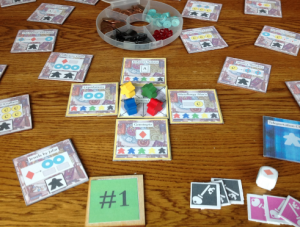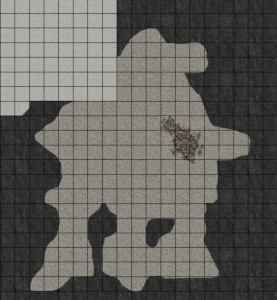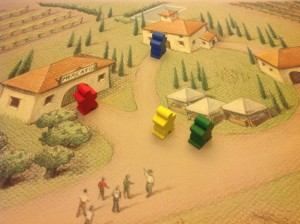Yesterday I talked about my first day at Gen Con 2013 and the experience of pitching my game designs to publishers. Today, I pick up where I left off in order to talk about Friday and Saturday. And yes, another reminder about the Chaos & Alchemy Kickstarter campaign!
Meeting 4: Medium publisher follow-up: Everest
On Friday while I was eating a late-ish lunch with my wife and a friend (at a restaurant called Patachou, which I STRONGLY recommend if you’re looking for healthy food within a block of the convention center at Gen Con), I received a phone call from a number I didn’t recognize. I decided to step outside and take the call – and I’m glad I did! It was from one of the publishers from the speed dating event who had seen Everest. This is a medium-sized publisher, with over ten card and board games in publication (plus role-playing games). The rep wanted to meet with me that day, so we set up a meeting for an hour later.
This was pretty exciting for me, as I wasn’t expecting to get attention from such a well-established company, especially for my secondary game! The meeting itself was great, I think. Since Everest is such a quick-to-play game, we were able to play an entire two-player game in about 15 minutes. We won in round 8, which was a fantastic result, too (Everest can be hard!).
The rep had lots of questions throughout the meeting, all of which I answered honestly and was glad to see that the rep liked the answers. In a couple of cases, I was worried that my answer would not be what this company was looking for, but it ended up being a really nice fit.
We talked a bit about a possible re-theme, which had also come up with some other publishers during the speed dating event. This was surprising to me, as Everest is really my only theme-first design so far (cooperative mountain climbing), but as I thought about it, I realized that the mechanics could also work for any theme where a group moves through tougher and tougher challenges. This could be a dungeon delve, a group infiltrating an enemy base, going through deeper layers of Hell, etc.
As with the previous night, I left this publisher with a no-bits prototype copy of Everest. I’m curious to see if this meeting leads anywhere!
Meeting 5: Pre-arranged meeting with up-and-coming publisher: Alchemy Bazaar
I had arranged to have dinner with the head of a small but quickly rising publisher Friday evening, after which we would play Alchemy Bazaar. Dinner ended up not working out, as the restaurant we met at had nothing my wife could eat (she has a gluten and soy allergy, and everything there was cooked in soybean oil), but the gaming afterward happened as planned.
I sat down with two people from the publisher and two of their friends and taught them to play Alchemy Bazaar. The game itself went just fine, though I realized that I hadn’t shuffled the Formula deck well enough and we ended up with a glut of gigantic Formulas on the board, which was not ideal. I plan to try cutting down the number of those Formulas in the deck, and to explore ways to cycle undesirable Formulas, too.
Anyway, it was a good experience, and the players were happy to sit and chat about the game afterward, offering great feedback. I was making it clear to publishers that I’m not done with the game yet – there are still a few things I want to play around with.
I got some good suggestions, as well as some ideas for other themes (one person suggested time travel, which blew my mind). I also loved hearing some thoughts about possible graphic design directions we could go with the game; for instance, making it look like a cave system with connecting passages or a deep forest with paths, if we were to re-theme it. That’s the sort of thing I never think of on my own, so it was really cool to hear.
This is a case where the publisher was already interested in Alchemy Bazaar before Gen Con, and I think the publisher is very much still interested. Good possibilities!
Addendum: After I originally wrote this but before the post went live, I received an email from this publisher telling me that his group had spent some more time talking about the game (an excellent sign) and he had a suggestion for a new theme: an archaeology dig! I love the idea, and I think it might be a great fit for the mechanics, too (possibly even solving one mechanical problem I’ve been wrestling with). I’m working on that theme now; we’ll see how it goes.
Meeting 6: Follow-up meeting with a large publisher: Robo Battle
This was a micro-meeting, and hard to arrange, but this came out of the publisher speed dating event from the publisher who asked, “What else have you got?” He wanted me to pitch Robo Battle to a colleague of his, and it was hard to nail down a time.
We finally made it happen at a point on Saturday when we each had only a few minutes before another meeting. I laid out the board (just a partial setup) and a few cards and explained how the mechanics worked. It was enough for the rep to get a feel for the game, and we’ll have some conversations in the future, but I have no idea whether this might amount to anything or not. If it does, great, but if not, that’s fine; this is still an embryonic design.
Meeting 7: Follow-up meeting with a small publisher: Alchemy Bazaar
This was another meeting that came out of the publisher speed dating event. The publisher and I set up a meeting via text message on Friday to meet Saturday afternoon (in my case, immediately after the Robo Battle meeting). We found ourselves a table in the big board gaming hall, and I taught the full rules to Alchemy Bazaar.
We played through one “day” of the game (the first of five rounds for a two-player game). It was enough for him to get a good feel for the game, and he made it clear that he really liked it. When he described what type of game he was looking for, he almost perfectly described Alchemy Bazaar (medium weight strategy game, not too heavy, somewhere between Caracasonne and Agricola).
My plan is to finish my design work on Alchemy Bazaar and then follow up with this publisher in October. This was another case where the publisher and I “clicked”.
Actually, I would say that I clicked with the publishers really well in every meeting except Meeting 1 (the very large publisher) and Meeting 6 (Robo Battle). And even in those two cases, we got along just fine; I’m just less optimistic that those two publishers came away feeling like, “Man, I really want to work with Michael.” I think that the other publishers felt that they would like to work with me, and I felt the same way about working with them.
Closing thoughts
Overall, I couldn’t be happier with the way things went at Gen Con 2013 for Clay Crucible Games. My Chaos & Alchemy demos were great. I got to meet some of my Kickstarter backers (thank you all!). I picked up some sweet metal dice to trick out my own copy of Chaos & Alchemy. We picked up lots of pledges for the Kickstarter campaign throughout the Con, with great momentum heading into the final few days.
And on the game pitching front, I was thrilled. Getting call-backs from well-established publishers, finding interest in THREE of my games (when I was really only planning to talk about two – and one of those only secondarily), building good relationships… it was everything I could have hoped for. I think that there is an excellent chance that both Alchemy Bazaar and Everest are going to see publication in the not-to-distant future, and I’m feeling really happy.
So, the main lessons I walked away with are:
- Be prepared with sell sheets and a polished, short pitch about how your game works and what makes it special
- Be honest with publishers about your game, no matter what
- Set up meetings ahead of time if you can
- Be prepared to be flexible with your schedule if meeting publishers at a convention
- Keep in mind that you’re partially selling yourself here; you want publishers to feel comfortable working with you, whether it’s on the game you’re pitching or something else that might come up in the future. Present yourself as someone who has their stuff together and is easy to work with.
And if you’ve found this post to be useful and it’s before August 23, 2013, as you read it, please also have a look at Chaos & Alchemy on Kickstarter! (Hey, this is my blog; I’m allowed to plug my Kickstarter, right?)
Michael Iachini
Clay Crucible Games (@ClayCrucible on Twitter)


























 Friday was Ashes of Athas Day One. I was running the three adventures from Chapter Three of the Dark Sun-set organized play campaign. I was delighted to discover that three of the guys whom I’d run Ashes of Athas for
Friday was Ashes of Athas Day One. I was running the three adventures from Chapter Three of the Dark Sun-set organized play campaign. I was delighted to discover that three of the guys whom I’d run Ashes of Athas for 



